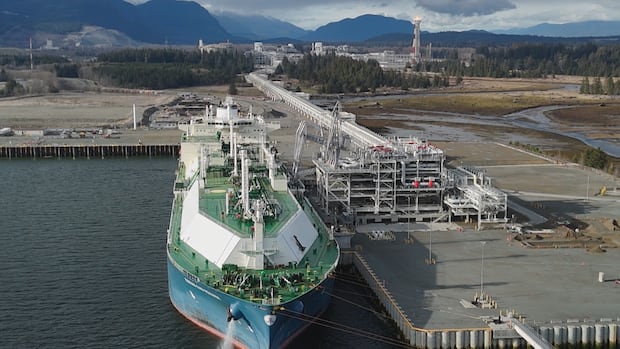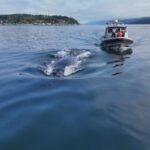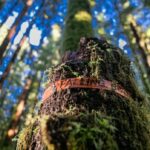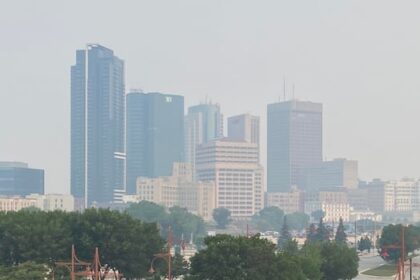British ColumbiaBoth of the B.C. projects, LNG Canada Phase 2 and the Red Chris copper and gold mine, will include expanding existing facilities. Expansions planned for LNG in Kitimat and Red Chris copper and gold mine near Dease LakeCBC News · Posted: Sep 13, 2025 1:46 AM EDT | Last Updated: 7 hours agoAn LNG tanker in Kitimat, B.C. in April 2025. A flare can be seen in the background as the Canada LNG project prepares to come online. (Maggie MacPherson/CBC)Prime Minister Mark Carney has announced a list of five major “nation-building” projects he wants to see sped up — and two of them are in B.C.Carney said he wants to fast-track the “projects of national interest” and reduce their approval timelines to a maximum of two years.All five of the projects have been referred to the federal government’s newly created “Major Projects Office” where they’re set to receive co-ordination with funding partners, guidance on regulations and project oversight.Both of the B.C. projects, LNG Canada Phase 2 and the Red Chris copper and gold mine, will include expanding existing facilities. Here are the basics of each project:LNG Canada: Phase 2 in Kitimat, B.C.What is the project?LNG Canada has just wrapped up its $40-billion Phase 1, after loading its first cargo of liquefied natural gas (LNG) for export in June.The joint venture company made up of Shell, Petronas, PetroChina, Mitsubishi Corporation and Korea Gas Corp. started the first phase in 2019, which included building two LNG processing units (also called LNG trains or liquefaction units) and the marine terminal.The Maran Gas Roxana LNG carrier navigates its way through the Douglas Channel to Kitimat, B.C., on Wednesday, April 2, 2025. (LNG Canada)The proposed Phase 2 would double LNG Canada’s production, which is currently 14 million tonnes of LNG per year, and make it the second-largest facility of its kind in the world, according to the prime minister’s press release.The release said emissions are projected to be 35 per cent lower than the world’s best-performing LNG facilities and 60 per cent lower than the global average.A front-end engineering and design contract has been awarded to the same companies that engineered the project’s first phase, but the company has not yet made a final investment decision.What is LNG?LNG is made from natural gas, a fossil fuel often extracted from northeast B.C. and Alberta through a practice called hydraulic fracturing, or fracking. It involves drilling down into the ground and injecting a mixture of water, sand and chemicals to force the release of underground oil and gas.The gas is then shipped via pipeline to terminals, which cool it to about –160 C, at which point it can be shipped overseas for use as a fuel.LNG is often referred to as “clean” because burning it for fuel causes fewer emissions than coal or oil, but that claim is disputed by some analysts because of the energy and destruction it takes to produce it.Some organizations have opposed LNG Canada and its Phase 2 expansion.The David Suzuki Foundation said in a press release Thursday that “Canada is taking a huge step back” by prioritizing LNG projects.Amnesty International Canada said Friday the fast-tracking undermines Indigenous rights and climate efforts.The open pits and waste rock pile at Red Chris Mine in the headwaters of the Iskut River, a major tributary of the salmon-bearing Stikine River, in B.C. An underground mine expansion is proposed under the open pit and is on the prime minister’s list of projects to fast-track. (Colin Arisman/colinarisman.com)Red Chris mine near Dease Lake, B.C.What is the project?The Red Chris mine, about 130 kilometres from the B.C.-Alaska border, made national news in July when two rock falls trapped three diamond drillers underground. The drillers were successfully rescued after 60 hours.The open-pit mine, which opened in 2015, is now transitioning to a new “block-cave” method of mining, which mines ore by collapsing rocks from above into tunnels below. This will allow the mind to expand its lifespan and produce more copper and gold.Red Chris is 70 per cent owned by Colorado-based Newmont Corp. and 30 per cent by Imperial Metals Corp. of Vancouver. (CBC)The mine is currently approved to produce 11 million tonnes of copper and gold ore per year until 2038, according to the B.C. government. Newmont Corp. said a block-cave mine at Red Chris would make it the largest of its kind in Canada and it is estimated to increase Canada’s annual copper production by more than 15 per cent annually, according to its project overview.The Red Chris mine was controversial at its outset. At the time, First Nations in B.C. and Alaska warned of its potentially negative impact on the environment.Protesters from Tahltan Nation, on whose lands the mine sits, blockaded the mine site in 2014. Now, however, the nation is fully involved with its operations.Why gold and copper?Newmont Corp. said increased production of gold would “meet global demand for industrial uses, financial investments and jewelry,” while increased production of the critical mineral copper would “support the global energy transition to low-carbon societies.”Copper has a number of uses, according to B.C.’s critical minerals atlas, including in the electric vehicle industry. It’s also used in ships, rail cars, aircraft and electrical transmission lines.With files from Lauren Vanderdeen, Benjamin Lopez Steven, Akshay Kulkarni and Andrew Kurjata
Carney picked 2 ‘nation-building’ resource projects to fast-track in B.C. What are they?











